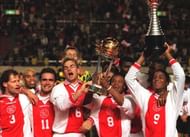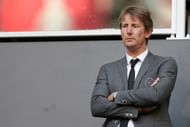Ajax Amsterdam is one of the most successful clubs in the world, with 33 Eredivisie titles and 18 KNVB Cups to its name.
The Lancers may have lost much of their pristine glory since the days of Rinus Michel’s European Cup exploits, but the Amsterdam-based outfit still maintains one of the most efficient and inventive youth academy set-ups the world has ever seen.
The Academy
Ajax’s youth academy is rakishly called De Toekomst — The Future. Situated beside a highway in an uninviting district of Amsterdam, the academy consists of eight well-maintained playing fields and a two-story building which features numerous locker rooms, tutorial rooms, gyms and offices for coaches and sports scientists.
Overlooking the training grounds is an airy café bar where the players are served nutritious meals to ensure their wholesome development and visitors often frequent the tavern to assess the progress of the youngsters over a pint of beer.
There is an air of grandeur and quality present in the academy blessed with world-class amenities as numerous coaches, several of whom donned the Oranje jersey in their heyday, are seen instructing the players about their technique and ways to improve their game .
Ajax occupies a mythical place in the game because of ‘Total Football’, a style the Dutch side pioneered in the late 1960s which emphasised quick-passing and even quicker offensive transitions with the players moving fluidly all over the pitch.
The globalization of the sport has driven the best players to richer and more alluring leagues in England, Germany and Spain, and Ajax have thus adapted themselves into a different kind of enterprise — a talent factory.
The Lancers manufacture promising players who are either promoted to the first team or are sold in the transfer market, often for large chunks of money.
Culture
The Ajax method focuses on scientific training, attention to detail and time spent in perfecting touches on the ball, where the onus is on the creativity and passion displayed by the players and not on the results which the team fetches.
Prospects touted to join the academy are observed for several months or even years before Ajax sends a letter to the player’s home inviting the parents to enrol their wards with the club. Ajax maintains a detailed dossier on each player from the moment they step into the De Toekomst. If a player is accepted into the academy, it would mean that he has overcome the first of a succession of relentless challenges.
The De Toekomst indulges in a culture of constant improvement, a competitive caldron in which players either make the grade and advance the ladder or are discarded for new prospects to prove their mettle. With the passage of time, the academy hardens the players mentally as well as physically.
Drills are practised again and again and then some more and players are instructed and educated to be at the right place at the right time as young boys strive to mould themselves into high-impact performers who could feature for the first team.
The Lancers strive to keep their football recognizable; attractive, offensive-minded, creative, fast, fair and as far away from their goal in the opponents’ half.
Ajax are the pioneers of the TIPS model, which signifies Technique, Insight, Personality and Speed. For each part, there are ten criteria; P and S are generally innate properties, but I and T can always be developed further.
Ajax coaching sessions always consists of 8 important football ingredients namely coordination training, kicking, passing and throw-in’s, moves to beat an opponent, heading, finishing, position play, position game play and small sided games.
The amalgamation of these 8 ingredients along with TIPS forms the core of Ajax’s success philosophy.
Stars produced and their Role in Ajax’s Success
Ajax have produced many impressive footballers over the years and the list includes yesteryear stars like Johan Cruyff, Marco van Basten and the De Boer siblings as well as current footballers Christian Eriksen (Tottenham), Daley Blind (Manchester United) and Wesley Sneijder (Galatasaray) among numerous others.
From 1994 to 1996, under the tutelage of Louis van Gaal, the Lancers completed an unbeaten run of 52 domestic matches and 19 UEFA Champions League games as 1995 recorded Ajax’s grandest success till date.
The 1995 Ajax team featured the likes of former youth teamers Edwin van der Sar, Frank Rijkaard, Clarence Seedorf, Ronald de Boer and Edgar Davids, who helped the team remain unbeaten for a full year in Europe as well as in the domestic league.
The coup of winning both the UEFA Champions League as well as the domestic league without a single defeat is a historical achievement unmatched to this day.
Other Ventures
Ajax had a satellite club in the United States under the name of Ajax America, but it is now defunct after filing for bankruptcy.
Ajax has also branched out to South Africa with Ajax Cape Town, with a few of their future players going on to feature for the senior club, namely South African internationals Steven Pienaar, Thulani Serero and Cameroonian international Eyong Enoh.
In 2011, AFC Ajax opened its first youth academy outside of the Netherlands called the Ajax Hellas Youth Academy. Their offices are based in Corfu, Greece, from where they host a total of 15 football youth academies throughout Greece and Cyprus.
Competition with other setups
No discussion surrounding the topic of youth development can be complete without the mention of Arsenal and Barcelona.
The Arsenal Academy and La Masia are famed conveyor belts of talent and they are regularly challenged by Real Madrid’s La Fabrica and Schalke’s Knappenschmiede albeit to a lesser extent. However, De Toekomst holds an edge over them all.
At Ajax, football is a way of life. Young Dutch players coming through the ranks of the capital club are taught to view the sport as a way of aiding their overall development and maturity and hence players who fail to make the cut also end up benefitting from the general experience on offer.
The above words were echoed by Ajax marketing director and ex-Manchester United keeper Edwin van der Sar when he joined Bergkamp, Overmars, De Boer and Jonk to work behind the scenes at the club.
“But we (Ajax) are small so we have to help each other, to make each other bigger. You have your plan for yourself and how you want to develop but Ajax gave us our first opportunity and we want to share our knowledge. We don’t have those big star players in the current squad who have experience of winning. We want to share that.”
“We accept that in one way now, if you are 27, 28 and still playing for Ajax you are probably not good enough for the top of Europe because players want to go to the top in Europe. So we have to make sure there are even quicker and stronger and better players for the first team than maybe three, four or five years ago. We want to have the best young team in Europe.”
Jasper Cillessen, Anwar El Ghazi, Jaïro Riedewald and Arkadiusz Milik are the latest bunch of promising players currently plying their trade for the first team. Their quality ensures that Ajax is in safe hands, but they may soon be forced to venture out of Amsterdam to try their luck in the other cash-rich European leagues.
Nowadays, Ajax fans rarely get to see the club hang onto their best players but the Amsterdam Arena faithful will take consolation in the fact that the founding fathers of youth development still produce world class footballers at an impressive rate, thus ensuring their domestic supremacy at the very least.



